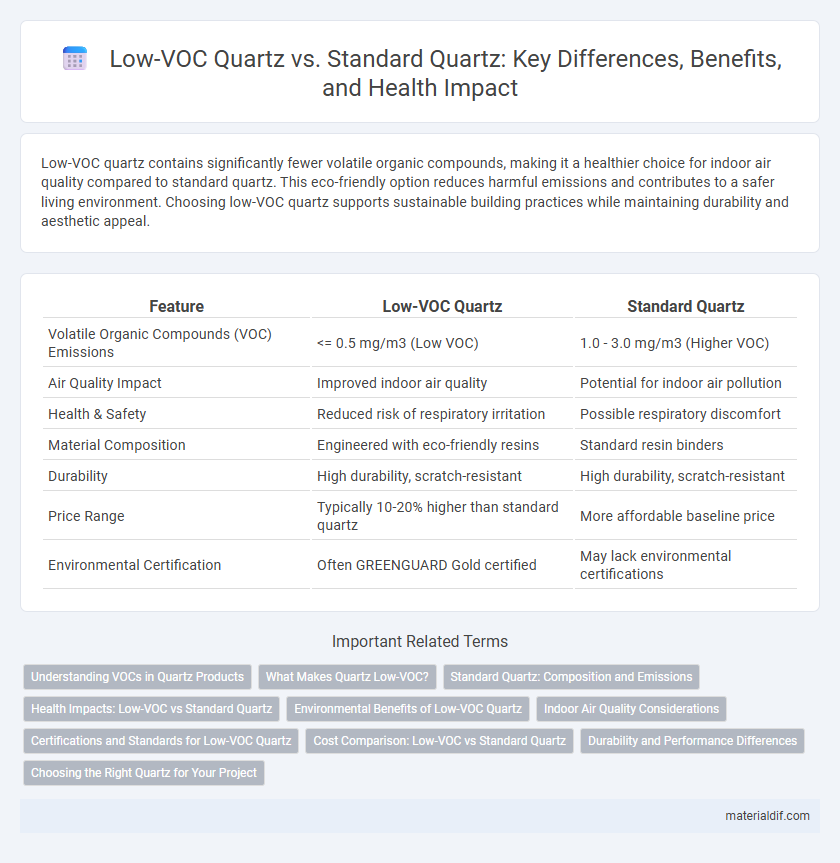Low-VOC quartz contains significantly fewer volatile organic compounds, making it a healthier choice for indoor air quality compared to standard quartz. This eco-friendly option reduces harmful emissions and contributes to a safer living environment. Choosing low-VOC quartz supports sustainable building practices while maintaining durability and aesthetic appeal.
Table of Comparison
| Feature | Low-VOC Quartz | Standard Quartz |
|---|---|---|
| Volatile Organic Compounds (VOC) Emissions | <= 0.5 mg/m3 (Low VOC) | 1.0 - 3.0 mg/m3 (Higher VOC) |
| Air Quality Impact | Improved indoor air quality | Potential for indoor air pollution |
| Health & Safety | Reduced risk of respiratory irritation | Possible respiratory discomfort |
| Material Composition | Engineered with eco-friendly resins | Standard resin binders |
| Durability | High durability, scratch-resistant | High durability, scratch-resistant |
| Price Range | Typically 10-20% higher than standard quartz | More affordable baseline price |
| Environmental Certification | Often GREENGUARD Gold certified | May lack environmental certifications |
Understanding VOCs in Quartz Products
Low-VOC quartz surfaces emit fewer volatile organic compounds, enhancing indoor air quality and reducing health risks compared to standard quartz, which can release higher levels of VOCs during installation or exposure. Understanding VOCs in quartz products is essential for selecting environmentally friendly options, as these compounds contribute to air pollution and respiratory irritation. Choosing low-VOC quartz supports healthier living spaces by minimizing toxic emissions commonly found in conventional quartz materials.
What Makes Quartz Low-VOC?
Low-VOC quartz is engineered using resins and adhesives specifically formulated to emit fewer volatile organic compounds, significantly reducing indoor air pollution compared to standard quartz. The low-VOC materials in these quartz surfaces minimize harmful emissions such as formaldehyde and benzene, contributing to healthier indoor environments. Advanced manufacturing processes incorporate non-toxic binders and enhanced curing techniques to ensure the quartz maintains durability while meeting stringent environmental standards.
Standard Quartz: Composition and Emissions
Standard Quartz countertops are primarily composed of approximately 90-95% natural quartz crystals combined with resin binders and pigments to achieve durability and aesthetic appeal. The resin used typically contains volatile organic compounds (VOCs) that off-gas low levels of formaldehyde and other chemicals during and shortly after installation. Emissions from standard quartz products can contribute to indoor air quality concerns, particularly if ventilation is inadequate, making low-VOC alternatives preferable for sensitive environments.
Health Impacts: Low-VOC vs Standard Quartz
Low-VOC Quartz significantly reduces indoor air pollution by emitting fewer volatile organic compounds compared to Standard Quartz, which can release higher levels of harmful chemicals like formaldehyde and benzene. Exposure to low-VOC materials in Quartz surfaces decreases respiratory irritation, asthma risk, and potential long-term health issues commonly linked to poor indoor air quality. Choosing Low-VOC Quartz enhances indoor environmental safety, making it a healthier option for homes and commercial spaces.
Environmental Benefits of Low-VOC Quartz
Low-VOC quartz significantly reduces the emission of volatile organic compounds, contributing to improved indoor air quality and a healthier living environment. This eco-friendly material minimizes harmful pollutants that can negatively impact respiratory health and reduce overall environmental toxins. Choosing low-VOC quartz supports sustainable building practices by lowering chemical off-gassing during installation and throughout the product's lifecycle.
Indoor Air Quality Considerations
Low-VOC quartz countertops significantly reduce the emission of volatile organic compounds, enhancing indoor air quality and promoting a healthier living environment. Standard quartz materials often contain higher levels of VOCs, which can contribute to respiratory issues and indoor pollution over time. Choosing low-VOC quartz supports better air quality by minimizing harmful chemical off-gassing in residential or commercial spaces.
Certifications and Standards for Low-VOC Quartz
Low-VOC quartz surfaces comply with stringent environmental and health certifications such as GREENGUARD Gold and FloorScore, ensuring minimal volatile organic compound emissions for safer indoor air quality. These certifications guarantee that low-VOC quartz meets rigorous standards set by organizations like the Collaborative for High Performance Schools (CHPS) and the U.S. Environmental Protection Agency (EPA). Standard quartz typically lacks these certifications, making low-VOC options preferable for eco-conscious and health-focused building projects.
Cost Comparison: Low-VOC vs Standard Quartz
Low-VOC quartz typically costs 10-20% more than standard quartz due to its enhanced environmental benefits and reduced emissions during manufacturing. While standard quartz offers a lower upfront price, low-VOC quartz provides greater value by promoting healthier indoor air quality and potential compliance with green building certifications. Budget considerations must weigh immediate costs against long-term health and sustainability advantages of low-VOC quartz surfaces.
Durability and Performance Differences
Low-VOC quartz offers enhanced durability due to its reduced chemical emissions, minimizing the risk of material degradation over time compared to standard quartz. Its advanced resin composition improves resistance to scratches, stains, and heat, ensuring longer-lasting performance in high-use environments. Standard quartz may have slightly higher VOC content, which can affect indoor air quality but generally maintains similar structural properties under normal usage.
Choosing the Right Quartz for Your Project
Low-VOC quartz surfaces release significantly fewer volatile organic compounds compared to standard quartz, enhancing indoor air quality and making them ideal for residential and commercial projects prioritizing health and sustainability. Choosing low-VOC quartz reduces exposure to harmful chemicals, aligning with green building certifications and strict environmental regulations. Evaluating project requirements such as usage intensity, aesthetic preferences, budget constraints, and environmental impact supports selecting the most suitable quartz material for long-term performance and safety.
Low-VOC Quartz vs Standard Quartz Infographic

 materialdif.com
materialdif.com